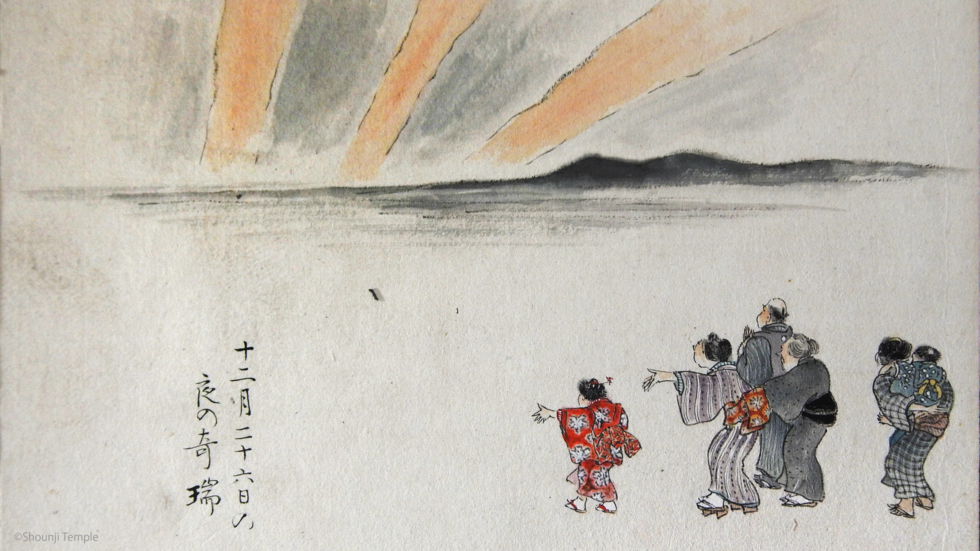
Mathematical and physical sciences
December 1, 2023
One of the largest magnetic storms in history quantified: Aurorae covered much of the night sky from the Tropics to the Polar Regions
In early November of this year, aurora borealis were observed at surprisingly low latitudes, as far south as Italy and Texas. Such phenomena indicate the impacts of a solar coronal mass ejection on the Earth's magnetic field and atmosphere. Far more dramatic than this recent light show was, it was nothing compared to a huge solar storm in February 1872. The resulting auroral display from that event ringed the globe and produced auroras observed in sites as close to the equator as Bombay and Khartoum. An international team consisting of scientists from nine counties has now published a detailed study of this historically important event, tracing its solar origin and widespread terrestrial impacts. Telegraph communications were widely disrupted by this storm, but in today's technologically dependent society, such a storm would disrupt power grids and satellite communications. Their findings confirm that such extreme storms are more common than previously thought.
In the modern world, we are increasingly dependent on technological infrastructure such as power grids, communication systems, and satellites. However, this dependency makes us increasingly vulnerable to the effects of large geomagnetic storms. “The longer the power supply could be cut off, the more society, especially those living in urban areas, will struggle to cope,” Designated Assistant Professor Hayakawa, the lead author of the study, explains. Such storms could be big enough to knock out the power grid, communication systems, airplanes, and satellites in the worst case. “Could we maintain our life without such infrastructure?” Hayakawa comments: “Well, let us just say that it would be extremely challenging.”
Such extreme storms are rare. In recent studies, two such storms stand out: the Carrington storm in September 1859 and the New York Railroad storm in May 1921. The new study suggests that another storm, the Chapman-Silverman storm in February 1872, should also be considered as one of these extreme events. At the time, the storm was big enough to affect the technological infrastructure even in the tropics. Telegraph communications on the submarine cable in the Indian Ocean between Bombay (Mumbai) and Aden were disrupted for hours. Similar disturbances were reported on the land line between Cairo and Khartoum.
The multidisciplinary team, consisting of 22 scientists, was led by Nagoya University in Japan (Hisashi Hayakawa), the US National Solar Observatory (Edward Cliver), and the Royal Observatory of Belgium (Frédéric Clette). The 22 researchers used historical records and modern techniques to assess the Chapman-Silverman storm from its solar origin to its terrestrial impacts. For the solar origin, the group turned to largely forgotten sunspot records from historical archives, especially Belgian and Italian records. For terrestrial impacts, they used geomagnetic field measurements recorded in places as diverse as Bombay (Mumbai), Tiflis (Tbilisi), and Greenwich to assess temporal evolution and storm intensity. They also examined hundreds of accounts of visual aurora in different languages caused by the storm.
One of the more interesting aspects of the 1872 storm was that it likely originated in a medium-sized, but complex, sunspot group near the solar disk centre as confirmed by analyses of solar records from Belgium and Italy. These findings suggest that even a medium-sized sunspot group triggered one of the most extreme magnetic storms in history.
A Belgian sunspot drawing showing solar surface on 3 February 1872
(RAS MS Bernaerts, v. 3, f. 26; courtesy of the Royal Astronomical Society)
Hayakawa and his colleagues extended their investigations of the historical aurorae by combing through records in libraries, archives, and observatories around the world. They identified more than 700 auroral records that indicated that the night sky was illuminated by magnificent auroral displays from the polar regions to the tropics (down to ≈ 20° in latitude in both hemispheres).
“Our findings confirm the Chapman-Silverman storm in February 1872 as one of the most extreme geomagnetic storms in recent history. Its size rivalled those of the Carrington storm in September 1859 and the NY Railroad storm in May 1921,” Hayakawa said. “This means that we now know that the world has seen at least three geomagnetic superstorms in the last two centuries. Space weather events that could cause such a major impact represent a risk that cannot be discounted.”
Hayakawa said: “Such extreme events are rare. On the one hand, we are fortunate to have missed such superstorms in the modern time. On the other hand, the occurrence of three such superstorms in 6 decades shows that the threat to modern society is real. Therefore, the preservation and analysis of historical records is important to assess, understand, and mitigate the impact of such events.”
Recent auroral displays have been observed from northern Greece and the northern US. Currently, the Sun is approaching the maximum of Solar Cycle 25, predicted to occur in 2025, and we may expect enhanced auroral activity in the coming years.
The study, “The Extreme Space Weather Event of 1872 February: Sunspots, Magnetic Disturbance, and Auroral Displays,” was published in The Astrophysical Journal on December 1, 2023, at DOI 10.3847/1538-4357/acc6cc.
This research involved a collaboration of researchers from nine countries.
Media Contact:
Matthew Coslett
International Communications Office, Nagoya University
icomm_research@t.mail.nagoya-u.ac.jp
Top image:
A Japanese auroral drawing showing an observation at Okazaki on 4 February 1872, as reproduced with courtesy of Shounji Temple.
(©︎ Shounji Temple)